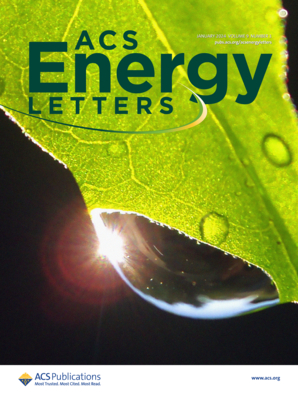Buried SnI2 Induces Gradient Heterojunctions in Sn–Pb Perovskite Solar Cells
IF 19.3
1区 材料科学
Q1 CHEMISTRY, PHYSICAL
引用次数: 0
Abstract
Tin–lead (Sn–Pb) mixed perovskite solar cells (PSCs) offer the potential for higher power conversion efficiency (PCE) than their pure lead counterparts. However, the lack of a well-defined Sn/Pb compositional profile results in disordered internal electric fields, limiting carrier separation. Here, we introduce a SnI2 predeposition strategy that induces a vertical Sn/Pb composition gradient within the perovskite film. This gradient forms a continuous heterojunction, establishing a built-in electric field that enhances carrier separation and directional extraction. As a result, the optimized devices achieve a PCE of 23.2% along with improved stability, retaining 89.6% of their initial efficiency after 1032 h of storage in nitrogen. This work demonstrates a compositional and interfacial engineering approach for advancing the efficiency and durability of Sn–Pb mixed PSCs.

求助全文
约1分钟内获得全文
求助全文
来源期刊

ACS Energy Letters
Energy-Renewable Energy, Sustainability and the Environment
CiteScore
31.20
自引率
5.00%
发文量
469
审稿时长
1 months
期刊介绍:
ACS Energy Letters is a monthly journal that publishes papers reporting new scientific advances in energy research. The journal focuses on topics that are of interest to scientists working in the fundamental and applied sciences. Rapid publication is a central criterion for acceptance, and the journal is known for its quick publication times, with an average of 4-6 weeks from submission to web publication in As Soon As Publishable format.
ACS Energy Letters is ranked as the number one journal in the Web of Science Electrochemistry category. It also ranks within the top 10 journals for Physical Chemistry, Energy & Fuels, and Nanoscience & Nanotechnology.
The journal offers several types of articles, including Letters, Energy Express, Perspectives, Reviews, Editorials, Viewpoints and Energy Focus. Additionally, authors have the option to submit videos that summarize or support the information presented in a Perspective or Review article, which can be highlighted on the journal's website. ACS Energy Letters is abstracted and indexed in Chemical Abstracts Service/SciFinder, EBSCO-summon, PubMed, Web of Science, Scopus and Portico.
 求助内容:
求助内容: 应助结果提醒方式:
应助结果提醒方式:


